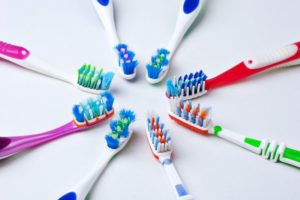How Often Should You Replace Your Toothbrush?
September 4, 2022

Do you remember the last time you replaced your toothbrush? If not, it’s probably time to do so. Regularly changing it out is an essential but often overlooked practice that can affect your oral health. Read on to learn from your dentist in Midland how often you should change out your toothbrush and what can happen if you don’t replace it as recommended.
When Should You Get a New One?
According to manufacturer guidelines and dentist recommendations, you should be replacing your toothbrush every 12-16 weeks. Following this rule is essential to get the most out of your brushing sessions. Straight soft bristles and an easy-to-grip handle are best to navigate the smaller spaces in your mouth, eliminating bacteria that cause gum disease, decay, and bad breath.
Ideally, you should be brushing your teeth for two minutes twice per day, between each meal, and after a sugary snack. At this rate, the CDC recommends replacing it as soon as the bristles fall out, appear splayed, or become worn out (typically 3-4 months). And if you or a household member has been ill, it’s best to get a new toothbrush after recovering to prevent getting sick again.
What Happens If You Don’t Replace It Regularly?
Each time you brush your teeth, the bristles are exposed to water and toothpaste chemicals, making them a little weaker after each use. Over time, the bristles also start to warp into a new shape and become frayed. Studies show that after 40 days of consistent use, worn-out bristles can make your toothbrush lose cleaning capability.
Those who didn’t change out their toothbrush after 40 days experienced significantly more plaque buildup. Additionally, two earlier studies confirmed that since old toothbrushes cannot remove plaque as effectively, it increases your risk of gum disease and decay.
Tips for Taking Care of Your Toothbrush
Taking care of your toothbrush is crucial to get the most out of your oral hygiene routine. Here are a few tips for maintaining it:
- Don’t share your toothbrush with anyone else
- Try not to let other people’s toothbrushes touch yours if they’re stored together
- Rinse your toothbrush with warm water after brushing
- Avoid using a closed container to keep your toothbrush clean, as it can encourage mold growth or spread bacteria
While shopping for a toothbrush, make sure you choose one that’s soft-bristled and has the American Dental Association (ADA) seal of approval. By changing it out every 3-4 months, you can maintain a happy and healthy smile that lasts for life!
About the Author
Dr. Laura Philipps earned her dental doctorate from Tufts University and she’s a member of the American Dental Association. She has studied extensively at many of the world’s most prestigious institutes, including the Pankey Institute in Florida, the KOIS Center in Washington, the Piper Institute of TMJ Studies in Florida, and Spear dental education in Arizona. As your dentist in Midland, Dr. Philipps will be happy to provide further toothbrush advice during your next checkup and cleaning. Schedule an appointment on her website or call (432) 570-4433.
No Comments
No comments yet.
RSS feed for comments on this post.
Sorry, the comment form is closed at this time.
